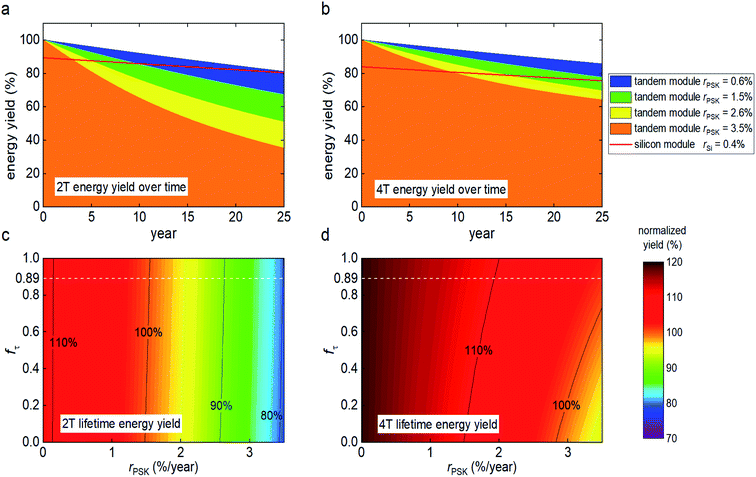 Open Access Article
Open Access ArticleCreative Commons Attribution 3.0 Unported Licence
Correction: Impact of perovskite solar cell degradation on the lifetime energy yield and economic viability of perovskite/silicon tandem modules
Jiadong
Qian
,
Marco
Ernst
*,
Nandi
Wu
and
Andrew
Blakers
Research School of Engineering, The Australian National University, Canberra ACT 2600, Australia. E-mail: marco.ernst@anu.edu.au
First published on 18th November 2019
Abstract
Correction for ‘Impact of perovskite solar cell degradation on the lifetime energy yield and economic viability of perovskite/silicon tandem modules’ by Jiadong Qian et al., Sustainable Energy Fuels, 2019, 3, 1439–1447.
The authors regret that in the originally published version of this article incorrect results were simulated and presented in Fig. 6 and related texts. This was due to an error in the reference silicon module efficiencies.
According to the cited ref. 3 by Quiroz et al. and ref. 25 by Sahli et al. in the main manuscript, the reported silicon solar cell efficiencies without perovskite filter are 22.6% for the two-terminal and 22.4% for the four-terminal configuration, respectively.
The initially published results were mistakenly referenced as 22.5% for the two-terminal and 21% for the four-terminal module. The incorrect cell efficiencies also impacted the energy yield simulations of the two reference Si modules, and lead to an overestimation of the energy gain from the perovskite top cells.
The authors would also like to note that a typographical error in the legend of Fig. 6 showing ‘rSi = 0.5%’ instead of the value of ‘rSi = 0.4%’ that has been used throughout the work must also be corrected. The correct value of rSi = 0.4% is used in the new Fig. 6.
On page 1444, Fig. 6 and the associated caption should be as follows.
On page 1444 the sentence “With fτ = 0.89, a 25.3% 2T tandem module would produce less total energy over lifetime than the module using 22.5% Si single-junction cells if the PSK cells degrade more than 1.5% per year.” is incorrect.
The corrected sentence is “With fτ = 0.89, a 25.3% 2T tandem module would produce less total energy over lifetime than the module using 22.6% Si single-junction cells if the PSK cells degrade more than 1.5% per year.”
On page 1446 within the Conclusion section, the sentence “A PSK cell degradation rate of over 2% per year would diminish the lifetime energy gain from the additional 2.7% tandem cell PCE in a 2T tandem configuration compared to the 22.7% efficient Si bottom cells” should be removed.
The sentence that should be included is “A PSK cell degradation rate of over 1.5% per year would diminish the lifetime energy gain from the additional 2.7% tandem cell PCE in a 2T tandem configuration compared to the 22.6% efficient Si bottom cells.”
The other key points of the Discussion and Conclusion sections are unaffected.
The Royal Society of Chemistry apologises for these errors and any consequent inconvenience to authors and readers.
| This journal is © The Royal Society of Chemistry 2020 |

